
| Top of SSF | Index | Table of Contents | Feedback |  |
Applicant Portal is a public Callista Connect application that enables:
For more information about Callista Connect, see Understanding Callista Connect.
This Help page contains the following information:
The following information assists the 'administrator' in understanding the complexities of Applicant Portal and the relationship between forms, jobs and reports. It is not intended to be Online Help for the 'applicant'.
Note: Before using Applicant Portal, applicants must first create an account via the Create Account application (APCRACNT). However, existing students can use their Student Connect Log in details to access Applicant Portal. (Go to, Starting Point, below for more information.)
Related SMS Forms
The following SMS forms (listed in alphabetical order by form code) affect the way Applicant Portal works:
| Form: | Description: |
|---|---|
| Maintain Citizenship Type (ADMF0285) | Use this form to define Citizenship Types that will be available to students using the Applicant Portal. |
| Admission Offer Response Status (ADMF02H0) | Use this form to record institution-defined Admission Offer Response Status Codes. |
| Maintain Tertiary Education Level of Completion (ADMF02L0) | Use this form to make Tertiary Education Levels of Completion available to students using the Applicant Portal . |
| Maintain Tertiary Education Level of Qualification (ADMF02K0) | To allow the mapping of System Admission Date Aliases to institution defined Date Aliases. |
| Maintain Admission Calendar Configuration (ADMF02R0) | For the Admissions Subsystem to operate, there are critical dates which must be specified. System flexibility allows institutions to choose the names for these dates. The Applicant Portal Final Date Alias is used to restrict the admission periods to be displayed to a person applying for admission via the Applicant portal. |
| Maintain Secondary Education Assessment Type (ADMF02W0) | This function allows
the recording of institution defined 'local' Secondary Education Assessment
Type Codes. A checkbox indicates if the is available in Applicant Portal. The Explanation field allows the display of more meaningful qualification information to applicants using the Applicant Portal. |
| Maintain Overseas Secondary Education Qualification (ADMF02Y0) | Use this form to record the institution defined Overseas Secondary Education Qualification Codes. The Explanation field allows the display of more meaningful qualification information to applicants using the Applicant Portal. |
| Maintain Admission Test Type (ADMF02Z0) | This form allows
the recording of institution defined Admission Test Type Codes. |
| Maintain Type of Place (ADMF0600) | Use this form to define Types of Place that will be associated with Course Versions (in CRSF1600) and Admission Categories (ADMF2M20), thus be available to students using the Applicant Portal. |
Maintain Access and Equity Category (ADMF0610) |
Use this form to define Access and Equity Categories that will be available to students using the Applicant Portal . |
| Maintain Applicant Portal Name Format (ADMF0620) | Use this form to define the name formats available to the Applicant Portal. |
| Maintain Applicant Portal Configuration (ADMF0900) | Use this
form to configure the address types for the recording of Domestic and International
Applicant Address details in the Applicant Portal. It also allows the institution
to set the maximum number of preferences that can be recorded by students
using the Applicant Portal. This form also controls a number of other functions, such as Email Address Type (even Reminder Emails), Default Alternative Person ID Type to link a Person ID to an Applicant ID, and various other settings. |
| Maintain Applicant Portal Transfer Status (ADMF0910) | Use this form to define Applicant Portal Transfer Statuses and map them to a System Applicant Portal Transfer Status. |
| Maintain Admission Category (ADMF2M20) | To allow the recording of institution defined Admission Categories and their mapping to Enrolment, Fee and Correspondence categories as well as their restriction to particular Student Status Options and Course Types and define Applicant Portal Rank. |
| Maintain Admission Process Category Details (ADMF2M30) | To allow the recording
of Admission Process Category details. The Citizenship Type field shows the institution-defined Citizenship Type(s) mapped to an Admission Category. |
| Direct Admission Person (ADMF3000) | To allow the direct
recording of Admission applications and maintenance of existing applications.
In particular, to record personal details of the applicant and to access
forms for the recording of Course and Unit application details. The field ‘AP # ’ (Receipt Number) is sourced from the Application Number from the Applicant Portal once the Applicant Portal has been transferred. |
| Direct Admissions Course (ADMF3240) | To allow the recording and maintenance of course details of an Admission Application. |
| Maintain Admission Application Access and Equity (ADMF32X0) | This function allows for the assigning of Access and Equity Categories to an Admission Application. These assigned Access and Equity Categories maybe used by Application Assessors to assist in determining whether or not an offer will be made to the applicant. |
| View Applicant Portal Summary (ADMF5000) | To view a summary of an Applicant's Application Portal details and results of the transfer process for applications. |
| View Applicant Email Log (ADMF5050) | Used to display a list of email messages that have been sent to an applicant. |
| Find Applicant Portal Applicant (ADMF5010) | To search for and find Applicants based on specific applicant data. |
| Maintain Applicant Portal Applicant Details (ADMF5100) | To view and edit Applicant details entered by an applicant in the Applicant Portal. |
| Maintain Applicant Portal Secondary Education Details (ADMF5110) | This form allows allow an administrator to view and edit Secondary Education details entered by an applicant in the Applicant Portal. |
| Maintain Applicant Portal Tertiary Education Details (ADMF5120) | This form allows an administrator to view and edit Tertiary Education details entered by an applicant in the Applicant Portal. |
| Maintain Applicant Portal Other Qualification Details (ADMF5130) | This form allows an administrator to view and edit Other Qualification details entered by an applicant in the Applicant Portal. |
| Maintain Applicant Portal Employment Details (ADMF5140) | This form allows an administrator to view and edit Employment details entered by an applicant in the Applicant Portal . |
| Maintain Applicant Portal Admission Test Details (ADMF5150) | This form allows an administrator to view and edit Admission Test details entered by an applicant in the Applicant Portal. |
| Maintain Applicant Portal Documents (ADMF5160) | This form allows an administrator to view and edit Document details entered by an applicant in the Applicant Portal. |
| Maintain Applicant Portal Applicant Applications (ADMF5200) | This form allows an administrator to view and edit Application details entered by an applicant in the Applicant Portal. |
| Maintain Applicant Portal Access and Equity Details (ADMF5300) | This form allows an administrator to view and edit Access and Equity details entered by an applicant in the Applicant Portal. |
| Maintain Applicant Portal Course Preference Details (ADMF5400) | This form allows an administrator to view individual Application Course Preference details and to edit details as required. |
| Maintain Applicant Portal Course Pref Unit Set Details (ADMF5500) | This form allows an administrator to view individual Application Course Preference Unit Set details and to edit details as required. |
| Maintain Applicant Portal Person Match Details (ADMF5600) | This form displays the results of matches found between the applicant record and existing Callista Person records as identified by the transfer process and based on the results of an institution-defined function. |
| Applicant Portal Transfer (ADMJ5000) | This function transfers submitted applications from the Applicant Portal tables to the Admission tables. |
| Inquire on Admission Course Application Instance History (AUDF3112) | To display history details for an applicant's Admission Course Application Instance. |
| Inquire on Admission Application History (AUDF3113) | To display history details for an applicant's Admission Application. |
| Course Type History (AUDF3121) | This form provides an interface to the Course Type History table which maintains an audit log of changes to the Course Type table. |
| Maintain Email Type (CORF2660) | The form will allow the creation of an institution-defined email type. |
| Maintain Email Substitution Tag (CORF2670) | This form allows an institution to define a collection of Email Substitution Tags that will be available for use when defining Email Types. |
| Maintain Course Types (CRSF1110) | This form allows for the definition of Course Types. Course Types are assigned to a Course Version to define the course. |
| Maintain Course Attendance Mode (CRSF1160) | To allow the creation and maintenance of institution defined Attendance Modes. The Explanation field allows the display of more meaningful information to applicants using the Applicant Portal. |
Maintain Course Attendance Types (CRSF1170) |
To allow the creation and maintenance of institution defined Attendance Types, and their definition in terms of load ranges. The Explanation field allows the display of more meaningful information to applicants using the Applicant Portal. |
| Maintain Basic Course Details (CRSF1210) | To enable the creation and maintenance of institution defined Courses and Details relating to Courses. A Type of Place button has been added to the 'Other Course Detail' button to take the user to CRSF1600. |
| Maintain Course Offering Unit Sets (CRSF1280) | The availability of the selected Course Offering Unit Set to the Applicant Portal (as inherited from CRSF4120) is displayed. This form can also be used to override the Course Offering Unit Set availability to the Applicant Portal. |
Maintain Admission Course Offering Option Admission Calendar Type Restriction (CRSF1350) |
Use this form to override the Applicant Portal Availability of Course Offering Options (as set in CRSF1400) to particular Admission Calendars. |
Maintain Course Offering Option (CRSF1400) |
Use this form to set the Applicant Portal Availability of Course Offering Options. |
| Maintain Course Offering Pattern (CRSF1500) | Use this form to define the Offering Patterns of Courses. |
Maintain COP Applicant Portal Admission Period Override (CRSF1520) |
Use this form to record Admission Period Override records for Course Offering Patterns. |
| Maintain Unit Set Categories (CRSF4120) | Use this form to set the availability of Unit Set Categories to the Applicant Portal. |
| Maintain Course Version Type of Place (CRSF1600) | This form enables an administrator to map institution-defined Types of Place to an individual Course Version. Used in the Applicant Portal Record Course Detail function to determine which Types of Place an applicant can select, based on the Course Offering Option they have chosen. |
| Maintain Unit Sets (CRSF4200) | When creating a new version of a unit set, this function allows the user to copy the old version by use of the “Duplicate Record Above” pull-down menu item. This creates a new version of the unit set and copies across a number of details from the old unit set to the new unit set – such as unit set course type and unit set field of study records. The process allows the roll over of the Override Unit Set Category availability for Applicant Portal data to the new unit set when using the “Duplicate Record Above” function. |
| Apply Unit Set to Course Offering (CRSF4201) | This function allows for a Unit Set to be attached to an individual Course Offering or to multiple Course Offerings. It allows the setting of the override unit set category availability for the Applicant Portal to have a value of ‘DEFAULT’ when a unit set is attached to single or multiple course offerings. |
Review of Course Version Creation (CRSR0630) |
This function reports on the data that will be added to the course version roll-over process in CRSF1210, in cases where the data is not successfully copied to a new course version. |
| Maintain Self Serve Application Data (SSFF1300) | This form is used to configure data displayed in Applicant Portal. For example, if institutions do not want the Withdraw Application button to be available in APAPPLLST, the Checked Value check box must be set to N for S-SELF_SERVE_APPL_DATA in this form. |
| Maintain Self Serve Access (SSFF1600) | This form allows users to enter Self Serve Access Codes and map them against Self Serve User Categories. |
| Inquire On AP Self-Serve Activity Log (SSFF4100) | This form provides a display of activities performed by applicants whilst using the Applicant Portal. These activities can be errors, warnings or information. It also provide an audit trail, allowing staff members to verify that a particular action was performed by an applicant at a particular point in time. |
| Delete Self-Serve Activity Log (SSFJ0010) | This job is used to remove activity log entries that are older than a specified number of days. |
Applicant Portal - Images of the Application List and Associated Screens and Forms
The following images reveal the process from entry into the Applicant portal, either from the Student Connect or the Login screen.
These images relate only to Course Applications. For details relating to Scholarship applications see Scholarships in Applicant Portal.
For details and instructions relating to Agents lodging applications on behalf of applicants, see Agents in Applicant Portal.
Application List (APAPPLST) Window
The first image shows screens (or applications) that lead to the Application List, and when in the Application List screen, where buttons on the screen take the user to. Note the administration form associated with the screen which administrators may use to edit/review the data relevant to that screen.

Standard Course or Non-award Course Process, including the Course Transfer Process
The second image shows the process of applying for a Standard Course (15 step process - blue) or Non-award Course process and the different screens that are shown in each of the steps. Note the actual form associated with the screen. Also shown is the Course Transfer process (five steps - purple).
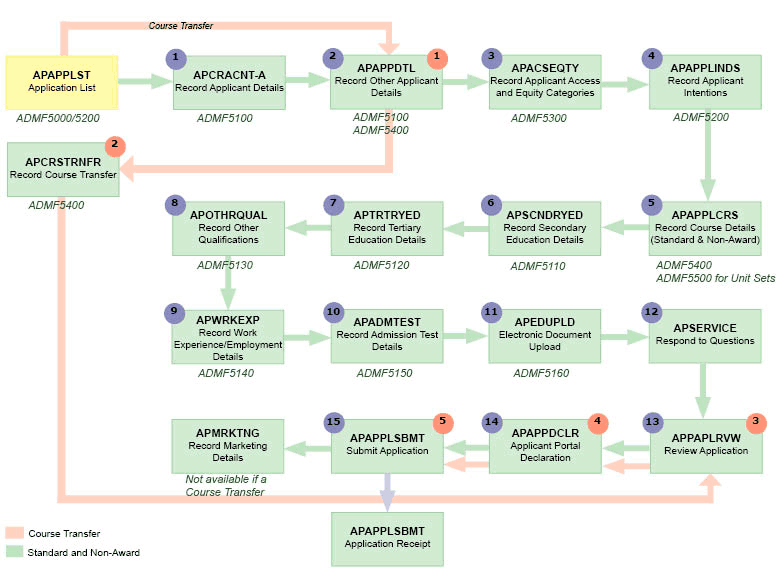
The following screens are shown in the logical order in which they appear in the Admission Portal Application Process and describe how the Applicant Portal is used. Screens (applications) which are accessed via buttons, such as on the Application List window, are listed under the Application List.
Existing students can access Applicant Portal:
1. From Student Connect
Or
2. Directly via Login (LGNAPPL)
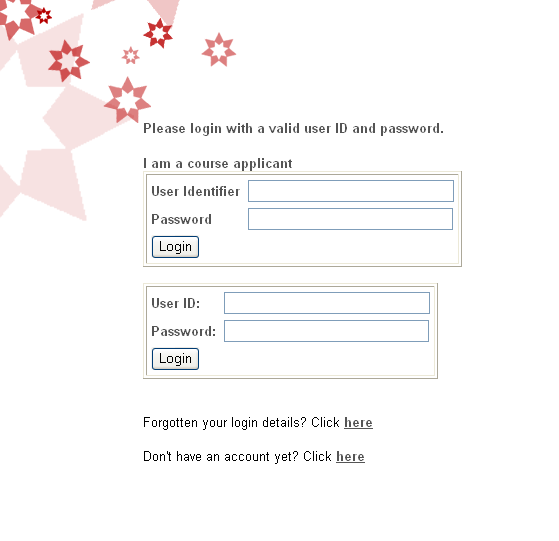
Request Account Details (APREQACDTL)
This function is invoked when an Applicant selects the forgotten Username or Password link from the login page. The Applicant is prompted to enter the email address they have previously recorded with their application. If the email address is matched to an Applicant record then the Security Question is displayed to the Applicant and the Applicant is prompted to enter an answer to the question. The answer entered is compared to the Security Question Answer that is held for the Applicant. If the answer matches, then a reminder email is sent to the email address recorded, using the Email Username/Password Reminder function. If the answer entered does not match the answer held for the Applicant, then the Applicant is informed and they are asked to try again. The Applicant can make as many attempts as required.
If the email address cannot be matched, the Application returns a message to the Applicant suggesting creating a new account in the Create Applicant Account screen.
If the email address does exist, and the Applicant is not active, then a message is displayed to the application informing them that their account is inactive and what action the user must take.
Optionally, the institution is able to ask the Applicant to provide an email address without having to answer a Security Question.
Validations include:
It is possible for existing students to gain access to Applicant Portal regardless of whether or not the institution has employed the CALLISTAID or LDAP authentication type for Student Connect.
Record Applicant Details (APCRACNT)
This application allows applicants to record their basic details, including their name, a preferred name format, date of birth, gender and an email address. The name format poplist only displays Name Format Codes that are mapped to the System Name Format Type of Applicant in ADMF0620.
This application creates user accounts which will allow applicants to login to Applicant Portal. It includes the following new fields:
If the surname, first name and date of birth match an existing applicant then the new account is not created and an error is generated with a message advising the user to contact their System Administrator.
On submitting the data, and assuming all validations have passed, a record is created in the AP_SELF_SERVE_USER table, which contains the Password, Security Question and Security Answer data. The CALLISTAID authentication logic uses this information when authenticating an applicant. The applicant’s username is system generated and will be the applicant ID.
Once the record has been inserted, an email is sent to the applicant advising them of their login details. A page is displayed telling the applicant that their account has been successfully created and that an email has been sent containing their login details. The page also contains a link which will take them to the applicant portal login page. It is important to note that, at this point, the applicant is NOT logged in. To log in they will need to click on the link to the login page and enter their login details as advised in the email.
In addition to the existing Create Applicant Account application, a self serve application needs to be created which is called when the applicant is logged in. This application is known as APCRACNT-A (Record Applicant Details - see below) and has its self serve access code set to ‘APPLICANT’. It is a virtual replica of APCRACNT, except that Password, Confirm Password, Security Question and Security Answer are not displayed. In addition, by default, the application is displayed in read-only mode, meaning none of the fields are editable by the user. If they wish, clients can set the fields to editable via metadata in SSFF1300. Please note, if the s_ap_transfer_status is not equal to NOT-APPLIC for the ap_applicant record, then the record cannot be updated regardless of the setup in SSFF1300.
Other validations that will fire upon pressing the ‘Continue' button will be:
If any of these validations fail, then the applicant is prevented from continuing to the next step and presented with an error message that identifies exactly what needs to be corrected.
If all validations complete successfully, then an applicant record is created in the Applicant Portal Applicant table, and the applicant presented with the next step in the process; Record Other Personal Details (APAPPDTL).
When this screen is called from the Review Application screen (APPAPLRVW), the navigation buttons will change from ‘Continue' to ‘Cancel/Save and Return'.
The Record Applicant Details screen is shown below:
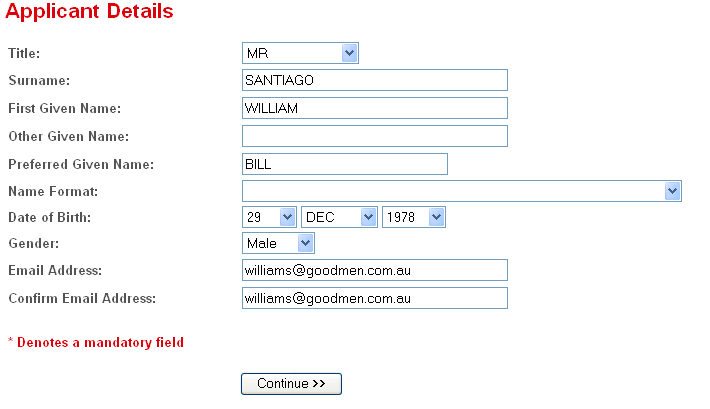
Application List (APAPPLLST)
This screen is divided into two main sections:
The Course Application section displays a list of Course applications that have been submitted or partially submitted by an applicant. It displays extended information on Course applications and provides links to functions, such as recording a Course Transfer application and recording a non-award application.
The applicant can track the overall progress of their applications in this screen. Should the applicant receive an offer (or a conditional offer) in a preference they will be able to navigate to the View Outcome Details and Respond to Offer function (APRESPOFFR) via the View Outcome Details button.
Course Preferences for an existing Applicant Portal application that were created by an administrator in the Direct Admissions Course form (ADMF3240) in SMS, are also listed on this screen.
Applications are listed by Submission Date (in descending order), Application Number (ascending), and Preference Number (ascending).
An unsubmitted application is one that has a System Transfer Status of NOT-APPLIC.
An Edit button is displayed for each unsubmitted application to enable the Applicant to navigate to another screen to update or complete the application (APCRACNT in context of the admission application).
Submitted Applications:
The View Application Details button allows the Applicant to view a submitted application through the Review Application function (APAPPLRVW).
Applicants have the option to withdraw a submitted application via the Withdraw Application button. The following applications can be withdrawn:
Note: SMS administrators can view a withdrawn application in ADMF5200.
Buttons:
The following fields will also be returned to the template. Although not displayed, they will be available for client use. The fields are:
The Scholarship Applications section displays information relating to Scholarships for which the applicant applied or is in the process of applying .
An 'Apply for Scholarship' button is available at the top of the screen (next to the other application buttons) and allows an applicant to create a new scholarship application. This button navigates to the first step of the Scholarship Application process, where the applicant can begin their application. If the applicant already has any non-submitted Scholarship Applications, then the details of these applications are available for update throughout this application.
The Scholarships Non-submitted Application section displays a list of all the scholarships that have currently been selected but have not yet been submitted. For Non-submitted scholarship applications, a single 'Edit' button is available, which navigates to the first step of the Scholarship Application process, loading any previously entered data. Applicants from that point will be able to navigate through each step of the application process, and update or enter new data as required before submitting their selected scholarship choices. Note that the 'Apply for Scholarship' button also navigates to the first step of the Scholarship Application process, and will function exactly the same way as the Edit application button, in that it will load data from any non-submitted scholarship application. This is to create consistency within the applicant portal while maintaining the single non-submitted application model.
Upon entry, this function will check that the non-submitted scholarships are still available for application. If a scholarship’s application period has passed then a lamp-style message will appear advising the applicant that they cannot submit an application for this scholarship.
The Submitted Scholarship section will display a list of all the scholarships that have been submitted, along with their application and outcome status.
The View Details button against a submitted scholarship will navigate to the Review Scholarship Application function (APSHRVW), in context of the selected scholarship only.
Below is a list of data for each scholarship that is referenced:
Non-Submitted Applications
Submitted Applications
Information shown on this screen is able to be edited and viewed in ADMF5000 and SCHF1020.
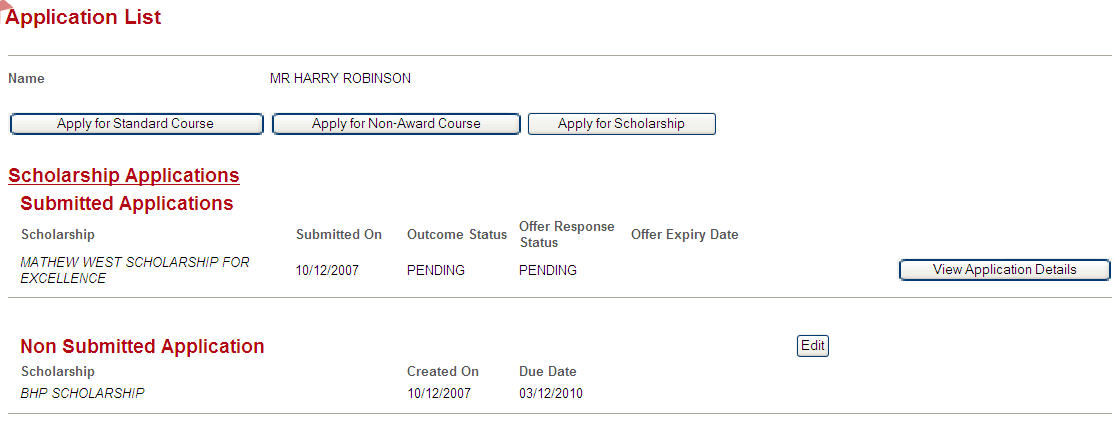
Invoked From:
Review Application (APPAPLRVW)
This screen displays all information entered by the applicant on one page. Additionally, the applicant is able to click on links that navigate to the step selected to enable them to update the details. Following any updates, the applicant is able to navigate directly back to this page, bypassing any steps.
A button to enable the applicant to view the Review Application details in a printer-friendly format is provided.The Edit buttons are not displayed when the application is accessed directly from the Application List (APAPPLST) for a submitted application.
Invoked From:
View Course Pref Outcome Details and Respond to Offer (APRESPOFFR)

This screen is part of the Application List (APAPPLST) window and is opened when the student selects the View Outcome Details button.
If an applicant has been granted an offer, or a conditional offer in a course preference, then they can access the View Course Preference Outcome Details and Respond to Offer screen from the Application List.
Course preferences for an existing Applicant Portal application that were added via the Direct Admissions Course form (ADMF3240), and have a system outcome status of OFFER or COND-OFFER, are also displayed and available for response.
The screen displays details of the Course Preference and the outcome of the application. It also allows an applicant to record an Offer Response Status, if applicable. The list of Offer Response Statuses the applicant can record is restricted to those with an Applicant Portal Available Indicator set to 'Yes'. It is not possible to record an Offer Response if the applicant has been given a conditional offer and the Conditional Offer Satisfied Date has not been recorded.
If the applicant is an Educational Services for Overseas Student (ESOS), the agreement text is displayed above the Course Offer information. The ESOS applicant must accept the agreement prior to accepting the course admission offer.
Note: Institutions have the option of incorporating the agreement and offer into one step. In this case an institution may choose to remove the Agreement text and/or the Accept button.
They also have the option of configuring the agreement text. Details included in paper-based offer letters and contracts can also be replicated by the institution in the Agreement text, if required.
The application displays the following agreement details for ESOS applicants:
The application displays the following details for all applicants, in the context of a course preference:
If a Student Course Attempt has a Fee Category defined and/or a Student Status that exists at the current date, then no change is made to the Fee Category value and/or Student Status when the Pre-enrolment process occurs. In these cases, depending on whether the pre-enrolment process occurs via ADMF3240 or ENRJ3100, a warning message is displayed in ADMF3240 or written to the S-LOG-ENTRY for ENRJ3100.
Once the information is selected, the student is taken back to the Application List window. See the Application List image above.
Invoked From:
Update Address Details (APUPDADDR)
This screen is part of the Application List (APAPPLST) window and is opened when the student selects the Update Address button.
The applicant can change their address details.
The applicant is asked if their address is in Australia, as per the Other Person Details Application (APAPPDTL) (Step 1 of 14 for an applicant applying for a Standard Course). The answer to this question is used to determine the Address Type as defined in the Maintain Applicant Portal Configuration form (ADMF0900).
If the applicant's Address Type is the same as the Domestic Address Type (as defined in ADMF0900), then the 'Yes' button will be pre-selected. If the applicant's Address Type is the same as the International Address Type (as defined in ADMF0900), then the 'No' radio button will be pre-selected. If the applicant’s Address Type does not match either of the configured address types, then no answer will be preselected and the person will need to answer the question before submitting the changed address.
Similarly to the Other Person Details Application, the address fields are displayed as per the Address Type definition.
The address lines display either the Applicant Portal address or the Callista SMS Person Address. To determine which address to display the following steps occur:
Once the information is selected, the student is taken back to the Application List window. See the Application List image above.
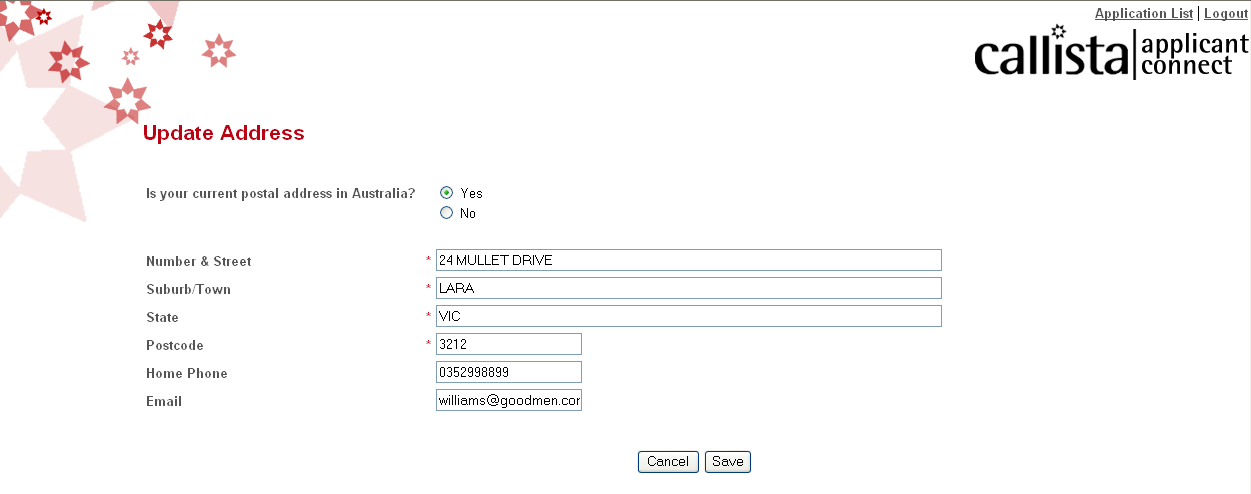
Invoked From:
Update Applicant Account (APUPDACCT)
This screen is part of the Application List (APAPPLST) window and is opened when the student selects the Update Account Details button.
It allows applicants to alter their Applicant Portal account details. These details include the password, security question and security answer.
This window returns details like Title, Surname, First Given Names, Other Given Names, Preferred Name and Name Format to the template to allow the name to be displayed in different ways.
When changing their password, the applicant must enter their existing password, their new password and re-enter their new password as confirmation. The change does not take place if the password does not match the password of the applicant. The password can not be updated if the new password and confirm new password aren’t the same.
When accessing this application, the security question and answer is populated by the applicants existing security details. These can be updated by the applicant or left as they currently are.
Once the information is selected, the student is taken back to the Application List window. See the Application List image above.
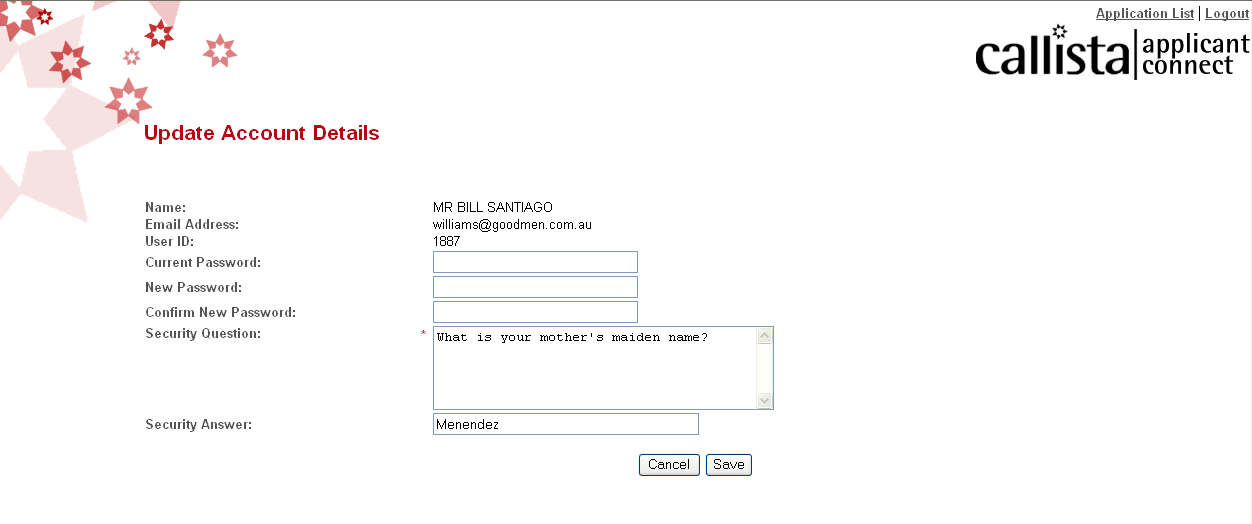
Invoked From:
Apply for Standard Course - Steps 1-14
After selecting the Apply for Standard Course Button in the Application List (APAPPLST), the following steps show in order, what the applicant is presented with to complete their application.
STEP 1
Record Applicant Details (APCRACNT-A)
Once the student selects the Apply for Standard Course button on the Application List they are taken to this window. This is the first step of fourteen that the student is taken through.
Within this application, the applicant can view their Title, Surname, First Given Name, Other Given Names, Name Format, Date of Birth, Gender, Registration Phone number, and Email Address.
By default, it is set up in the system self-serve application template and application data so that applicants can only view the data but the application can be changed (in the system self-serve application data) to allow the applicant to update the information while the applicant system transfer status is NOT-APPLIC.
Once the applicant details are transferred to SMS and a Person record created there, if the applicant views their details again in APCRACNT-A in Applicant Portal, the following fields are no longer displayed: Other Given Name, Name Format, and Registration Phone Number.
This application is altered to display the details of the applicant from Callista SMS when the application is accessed by an applicant who has an associated person record (as defined in Alternate Person ID) or by a student that does not have an applicant record.
Note: The following examples do not show all possibilities of screen shots. Depending on what button is selected reveals or hides other details on the screen.
Invoked From:
Information shown on this screen is controlled by Maintain Applicant Portal Applicant Details (ADMF5100).
An example of what Step 1 could look like.
STEP 2
Record Other Person Details (APAPPDTL)
The purpose of this screen is to allow the applicant to enter various personal details such as correspondence address, citizenship type, visa and passport information, and a CHESSN.
Fields that the applicant must enter will vary depending on the data recorded for particular fields.
The applicant is asked whether they have previously been a student at the institution (or a related institution). For greater clarity, the institution may wish to specify the names of the related (i.e. antecedent) institutions in the question text. If they answer ‘Yes' to this question the following fields are enabled:
The applicant is asked to choose a Citizenship Type. The Citizenship Type is an institution-defined value that is mapped to a system value of INTRNTNL or DOMESTIC (in ADMF0285).
When this application is accessed by a continuing student (where the continuing student indicator is Y, refer to the Application List) and the System Application Type is not 'Course Transfer', then only the Citizenship Type and the Visa details will be displayed. However, the Visa details will only display if the chosen Citizenship Type has a system value of INTRNTNL (International).
When an applicant updates their Citizenship Type response, a warning will be displayed advising the applicant that they may no longer be eligible for their selected course preferences or scholarships and recommending that they review them.
If the System Citizenship Type entered is mapped to INTRNTNL, the following fields will be displayed for the applicant to enter:
They will be also be asked the question 'Have you applied for permanent residency?' If the response is ‘Yes', the ‘Date of Application for Permanent Residency' field will be enabled.
If the System Citizenship Type selected is DOMESTIC, the CHESSN field will be displayed instead.
The applicant is also asked whether their current correspondence address is an Australian address. If they answer ‘Yes' to this question they are presented with all the address lines of the address type that the institution has indicated is the Australian address type for the eAdmissions Applicant Portal (in ADMF0900). If they answer ‘No' the address lines from the address type indicated as the overseas address type (in ADMF0900) for the eAdmissions Applicant Portal are enabled.
The applicant can update their address irrespective of the Applicant System Transfer Status. This ensures the applicant can always update their address when it changes.
Applicants are able to record a previous surname, if applicable, in the Previous Surname field. This field is only displayed for applicants who are not continuing students. (This data may be used to match the applicant with an existing Person record in SMS.)
Invoked From:
Information shown on this screen is controlled by Maintain Applicant Portal Applicant Details (ADMF5100) and Maintain Applicant Portal Course Reference Details (ADMF5400).
An example of what Step 2 could look like.
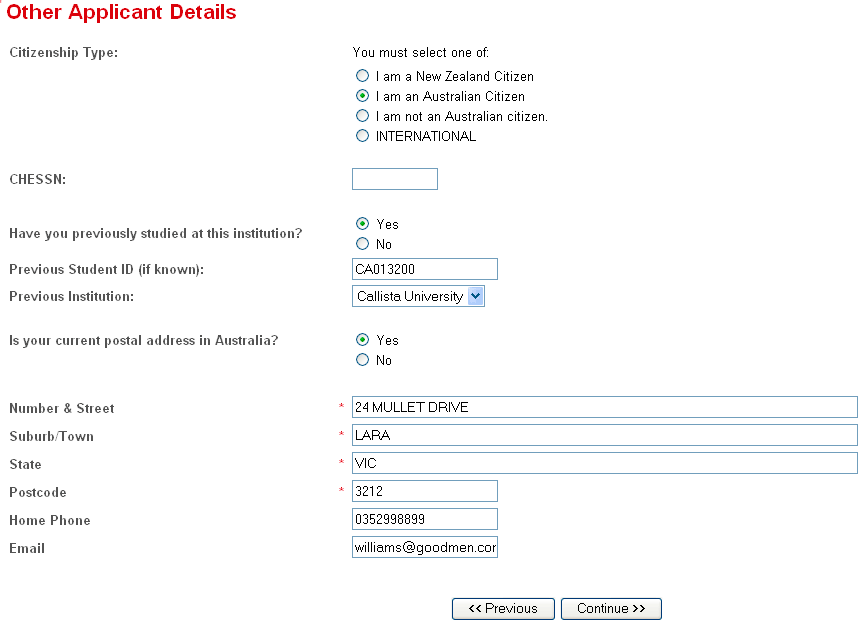
STEP 3
Record Application Access and Equity Categories (APACSEQTY)
The purpose of this screen is to allow applicants to select one or more Access and Equity Categories, when registering an application. The applicant may also choose to provide an additional comment in conjunction with the selected category(ies).
Applicants may indicate any Access and Equity details they believe are pertinent to their application.
When this screen is called from the Review Application screen, the navigation buttons will change from ‘Previous/Continue' to ‘Cancel/Save and Return'.
Information shown on this screen is controlled by Maintain Applicant Portal Access and Equity (ADMF5300).
Invoked From:
An example of what Step 3 could look like.
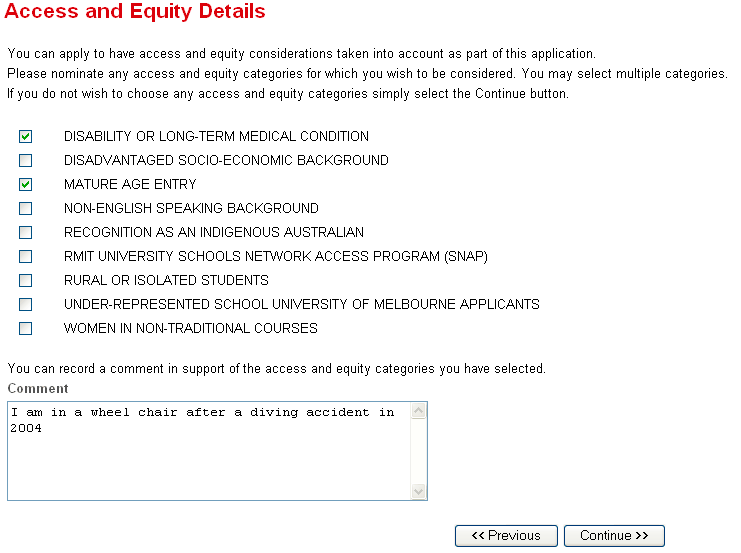
STEP 4
Record Application Intentions (APPAPLINDS)
The purpose of this screen is for the applicant to record if they intend to apply for:
This will be recorded across the whole admission application rather than for each course preference.
When this screen is called from the Review Application screen, the navigation buttons will change from ‘Previous/Continue' to ‘Cancel/Save and Return'.
Information shown on this screen is controlled by Maintain Applicant Portal Applicant Applications (ADMF5200).
Invoked From:
An example of what Step 4 could look like.

STEP 5
Record Course Details (APPAPLCRS)
The purpose of this screen is to allow the applicant to search for courses (including Non-award) and add course preferences to their application. In addition to recording course preferences, an applicant is able to identify an intended Commencement Period, intended Unit Set and a preferred Type of Place for each preference.
(For a Non-award application, the applicant is presented with an extra screen in the course preference selection. This screen allows an applicant to add unit details to their course preference. This unit field is also added to the edit preference screen).
The initial screen enables the applicant to add a course, by directly keying the details of a valid Course Offering Option (COO), or search for a Course. The applicant is able to initiate a course search using the fields: Course Code, Course Title, Field of Study, Location, Attendance Mode and Attendance Type. The applicant is not required to enter a wildcard in order to have a wildcard attached to text fields in the search. For example, if the applicant simply enters 'Psychology' in the Course Title field, the search will automatically add wildcards to the start and the end of the string, allowing for all Course Titles containing Psychology to be returned.
If more than one COO is returned the search returns a list of all COOs that match the criteria and are available to the applicant in the Applicant Portal. Once the applicant has selected a COO, they proceed to record a Commencement Period.
If only one COO is found it is selected by default and the applicant moved to the Commencement Period screen.
For a course and COOs to be available in Applicant Portal, both the 'Offered' and 'Entry Point' indicators must be checked in the Maintain Course Offering Patterns form (CRSF1500), regardless of the state of any other Applicant Portal indicators, dates or overrides.
If a Course Offering Pattern (COP) does not exist for a COO, then that COO will be unavailable (and the 'Select' radio button is greyed out).
To determine if a particular COP is available to Applicant Portal in a particular Admission Period for a particular Course Transfer Applicant, the start and end dates defined against the Admission Period in the Maintain Applicant Portal Configuration form (ADMF0900) are used, or if present, the COP Applicant Portal Admission Period Override. If today’s date is between and inclusive of the Start and End Dates defined at the override or the Admission period, then the COO will be available for selection.
Institutions have the option of displaying available COOs only or both available and unavailable COOs, by deselecting or selecting the 'Include Unavailable COOs in the Course Search Results' checkbox in ADMF0900.
If the 'Include Unavailable COOs in Course Search Results' checkbox is selected both available and unavailable COOs are returned to the Course Search Results template where the institution can choose whether or not to include the unavailable COOs in the Search Results list displayed in APAPPLCRS. If the institution chooses to include the unavailable COOs in the Search results list, these COOs cannot be selected by the applicant.
If the 'Include Unavailable COOs in Course Search Results' checkbox is deselected, only available COOs are returned to the Course Search Results template and hence also in the Search results list displayed in APAPPLCRS.
When a COO is selected, a list of available Commencement Periods are displayed to the applicant. The applicant is required to select a Commencement Period before continuing to the next step.
One of the Commencement Period options is 'Other', which allows the applicant to enter a preferred Start Period (from a list of institution-defined values) if their preferred Commencement Period is not on the list.
Following selection of a Commencement Period, the applicant is asked to select a Unit Set for the course preference. Only Unit Sets that are available to the applicant in the selected Course Offering Option are displayed.
A domestic applicant is also able to record a Type of Place for the course preference.
Once these details have been recorded the applicant is taken back to the Course Search screen to add another preference, if required. Details of previously added preferences are also displayed. At this point, the applicant is able to change Preference Order, Commencement Period, Unit Set, or Type of Place for those preferences already added.
When this screen is called from the Review Application screen, the navigation buttons will change from 'Previous/Continue' to 'Return to Review Application'.
Information shown on this screen is controlled by Maintain Applicant Portal Course Reference Details (ADMF5400) and Maintain Applicant Portal Course Pref Unit Sets (ADMF5500) for Unit Sets.
Invoked From:
An example of what Step 5 could look like.
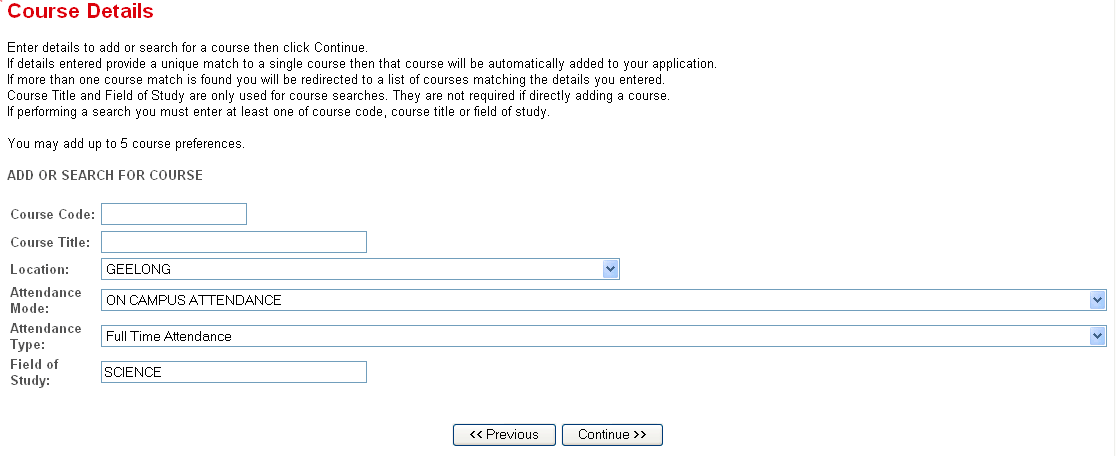
When the Continue button is selected, this is an example of the next screen.

When the Continue button is selected, this is an example of the next screen.
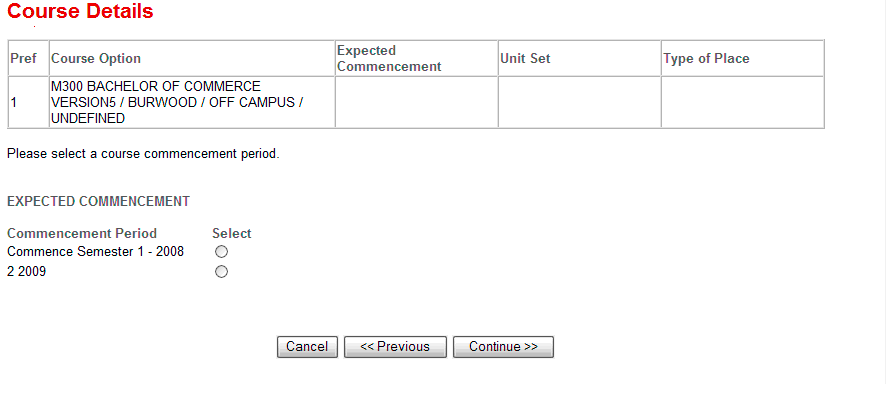
When the Continue button is selected, this is an example of the next screen.

An Edit button is displayed for each unsubmitted application to enable the Applicant to navigate to another screen to update or complete the application.
STEP 6
Record Secondary Education Details (APSCNDRYED)
The purpose of this screen is to record the applicant's Secondary Education Details. The applicant may have completed their secondary education domestically and/or internationally, therefore this screen is able to record both types. The information that is collected is different, depending on where the applicant completed their education (in Australia or Overseas).
Only Secondary Education Assessment Types that have their Applicant Portal Available indicator set in ADMF02W0 are available.
More than one record of Secondary Education can be added by the applicant.
The screen also permits the applicant to view previously added Secondary Education details.
When this screen is called from the Review Application screen, the navigation buttons will change from ‘Previous/Continue' to ‘Return to Review Application'.
The list is restricted to Applicant Portal records where the System Applicant Portal Transfer Status is not TRANSFERRD or PRE-EXISTS.
Information shown on this screen is controlled by Maintain Applicant Portal Secondary Education Details (ADMF5110).
Invoked From:
An example of what Step 6 could look like.
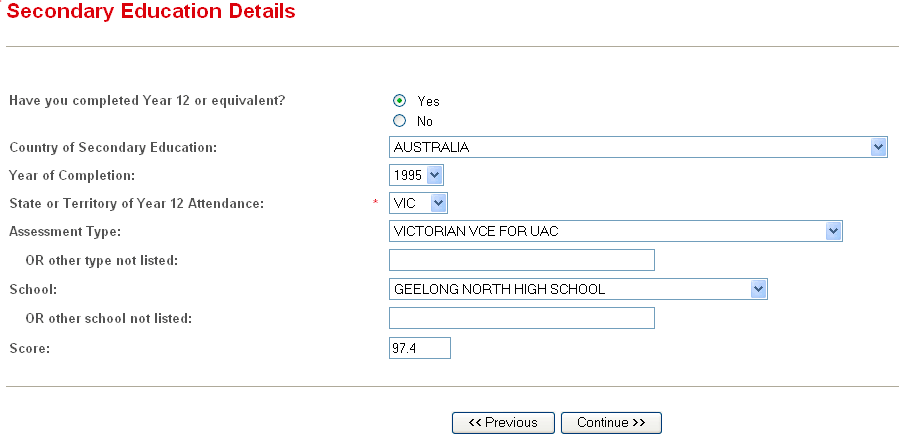
When the Continue button is selected, this is an example of the next screen.

STEP 7
Record Tertiary Education Details (APTRTRYED)
The purpose of this screen is to record the applicant's Post-Secondary/Tertiary Study Details. The applicant may have completed their Post-Secondary/Tertiary Study domestically or internationally. Therefore, this screen is able to record both types. The information that is collected is different, depending on where the applicant completed their study.
More than one record of post-secondary/tertiary study can be added by the applicant.
The screen also permits the applicant to view previously added Post-Secondary/Tertiary Study Details.
When this screen is called from the Review Application screen, the navigation buttons will change from ‘Previous/Continue' to ‘Return to Review Application'.
The list is restricted to Applicant Portal records where the System Applicant Portal Transfer Status is not TRANSFERRD or PRE-EXISTS.
Information shown on this screen is controlled by Maintain Applicant Portal Tertiary Education Details (ADMF5120).
Invoked From:
An example of what Step 7 could look like.
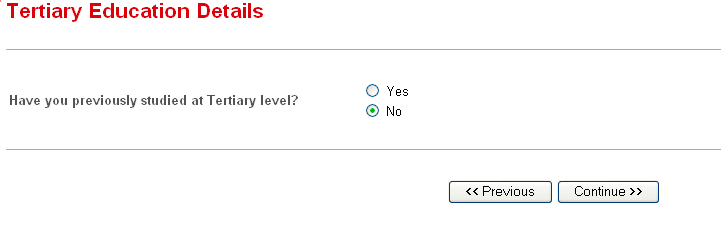
STEP 8
Record Other Qualifications (APOTHRQUAL)
The purpose of this screen is to enable an applicant to record Other Qualifications that they have obtained outside of mainstream education. For example, professional body membership and short courses completed via employment.
An applicant records details of any Other Qualifications that they would like to submit in support of their application. They can select from a Qualification Type list or, if the qualification is not in the list, there is provision to record the Qualification Type as free text.
The screen also permits the applicant to view previously added Other Qualification Details (as it does from all applications) within the same Admission application.
When this screen is called from the Review Application screen, the navigation buttons will change from ‘Previous/Continue' to ‘Return to Review Application'.
Information shown on this screen is controlled by Maintain Applicant Portal Other Qualification Details (ADMF5130).
Invoked From:
An example of what Step 8 could look like.

STEP 9
Record Work Experience - Employment (APWRKEXP)
The purpose of this screen is to enable an applicant to record details of their Work Experience or Employment History.
For each work experience/employment record, the applicant provides details of the position held and also information about the employer.
The screen also permits the applicant to view previously added Employment/Work Experience Details.
When this screen is called from the Review Application screen, the navigation buttons will change from 'Previous/Continue‘ to 'Return to Review Application'.
The list is restricted to only Applicant Portal records where the System Applicant Portal Transfer Status is not TRANSFERRD or PRE-EXISTS.
Invoked From:
Information shown on this screen is controlled by Maintain Applicant Portal Employment Details (ADMF5140).
An example of what Step 9 could look like.
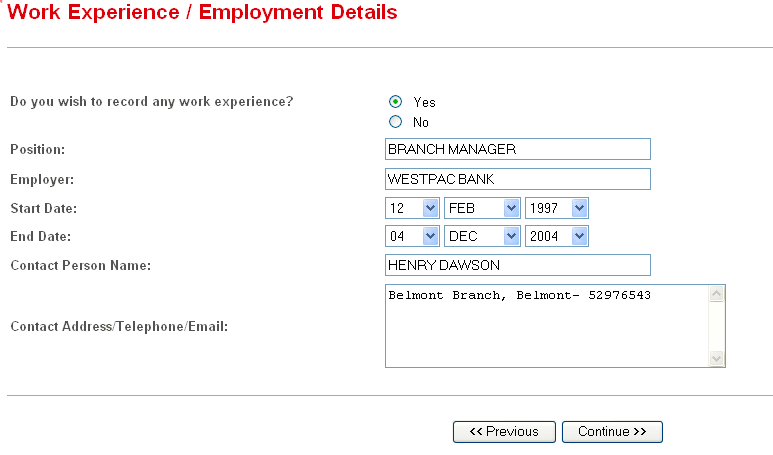
When the Continue button is selected, this is an example of the next screen.

STEP 10
Record Admission Test Details (APADMTEST)
The purpose
of this screen is to provide the ability for an applicant to record Admission
Test details in support of their application. (Only Admission Test Types that have their Applicant Portal Available indicator set in ADMF02Z0 are available.)
It is possible to add multiple
Admission Test records to each application via the Add New Record button.
Applicants enter the date the test was completed, the score, and grade or result.
If the completed test details include sub-scores (as defined in ADMF02Z0), the applicant can record the sub-score, sub-score type, and sub-score explanation or description on this screen. The sub-scores for each of the sub-score types will be transferred to Callista SMS by the Applicant Portal Transfer job (ADMJ5000).
An applicant can also record details of a planned or incomplete Admission Test. If the applicant indicates that the test is planned or incomplete, then they must record the date that they intend to sit the test, in the Planned Date of Test field.
The screen also permits the applicant to view previously added admission test details within the same Admission application.
The list of Test Details displayed is restricted to records where the System Applicant Portal Transfer Status is NOT TRANSFERRD or PRE-EXISTS.
A validation ensures the score/grade/result are only mandatory if the Admission Test Type enforces mandatory results.
Invoked From:
Information shown on this screen is controlled by Maintain Applicant Portal Admission Test Details (ADMF5150).
An example of what Step 10 could look like:
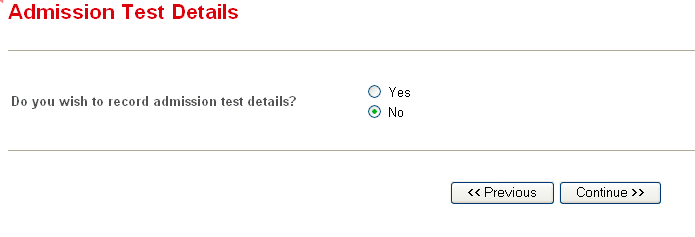
STEP 11
Electronic Document Upload (APEDUPLD)
This function allows an Applicant to electronically submit documents as part of their application. The Applicant can browse through local documents and select the file/s to load. For example, an Applicant may wish to submit their academic transcript. As part of submitting a document, the Applicant will need to choose the type of document that is being submitted. Document Types and individual document size limits are predefined by the institution.
The total maximum size of all documents that can be uploaded for an Applicant cannot exceed the maximum size limit specified in the 'Max Total Document Size' field in the Maintain Applicant Portal Configuration (ADMF0900) form. (Note: This is an accumulative total and includes all previously uploaded documents for the Applicant.) Once this size limit is reached, no further documents can be uploaded. If no value is specified in this field, then there is no restriction on the maximum total size of all documents that can be uploaded for an Applicant.
Apart from submitting a document, an Applicant is able to view a list of any previously uploaded files and have the option of deleting files. Only documents that have an institution-defined Transfer Status mapped to a system Transfer Status of NOT-APPLIC can be deleted.
If a person with an existing Applicant ID and a Person ID, uploads a document through the Electronic Document Upload facility (APEDUPLD), the documents are viewable in GENF0150 on completion of the upload process (i.e. Applicant Portal Transfer job).
The institution is able to configure the text on the screen to advise the Applicant on the sorts of documentation required in support of their application. In particular, the template returns data such as the steps in which the applicant has recorded information and the applicant’s course code.
Validations include:
Invoked From:
Information shown on this screen is controlled by Maintain Applicant Portal Documents (ADMF5160).
An example of what Step 11 could look like.
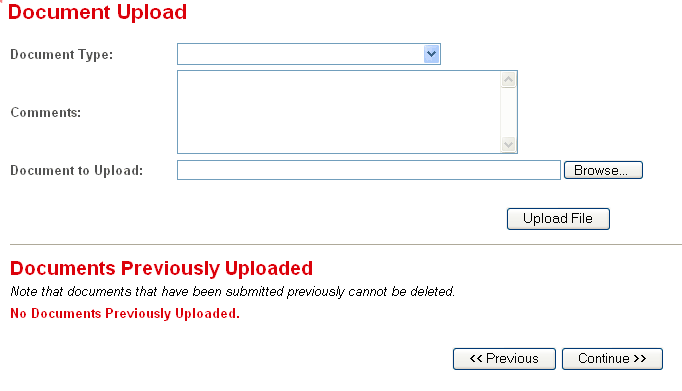
STEP 12
Respond to Questions (APSERVICE)
The purpose of this screen is to enable applicants to view and respond to institution-defined service related questions. These questions have been defined in the Maintain Services form (ENRF01Y0).
An institution is able to determine which questions to display on screen and the order in which they are displayed. Multiple instances of this screen can be created by an institution, if required, each with a different template and configuration.
Mandatory questions are marked with an asterisk.
When a response is recorded to a question with a Service Type of AP Applicant, no Application number is recorded in the response record. When a response is recorded to a question with a Service Type of AP Application, the application number will be recorded with the response.
If a response record already exists in the database for a specific response to a question (i.e. with the same Applicant ID, and, if applicable, Application Number) then the response will be pre-selected on the screen.
If the applicant updates a question with a new response, the end date of the existing open record is updated to the system date, minus one day. A new record is created with the system date as the start date, and a null end date. However, if the update is done when the start date equals the current date then the existing record will be updated.
If a question with an existing answer is closed by an institution, the question is not displayed on this screen, and the answer is automatically End Dated with the current date (i.e. today's date) minus one day.
Closed questions will appear in Review Application (APPAPLRVW) for a submittted application if an answer exists for that question, as at the Submission Date, so that the applicant is able to view the closed question and provided answer(s).
Answers for closed questions for a non-submitted application are not displayed in APPAPLRVW.
Invoked From:
An example of what Step 12 could look like.
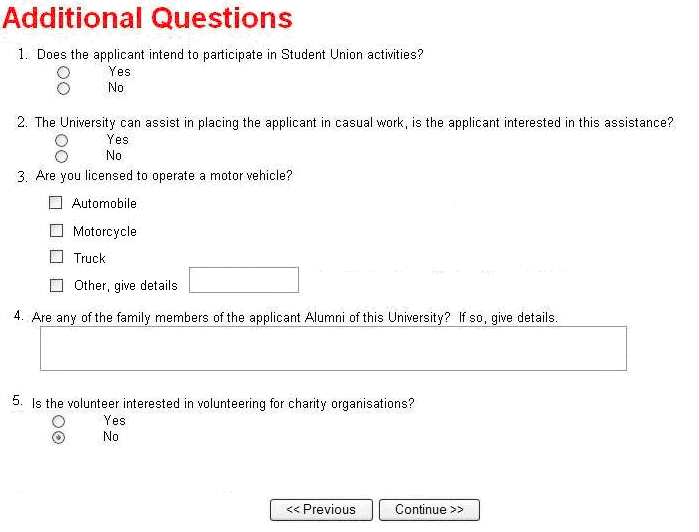
STEP 13
Review Application (APPAPLRVW)
This screen displays all information entered by the applicant on one page. If any of the information is incorrect they can access each step to correct the information and return to the review application. Following any updates, the applicant is able to navigate directly back to this page, by-passing any steps.
A button to enable the applicant to view the Review Application details in a printer-friendly format is provided.The Edit buttons are not displayed when the application is accessed directly from the Application List (APAPPLST).
When accessed for a course transfer application this application will be altered to only display:
When accessed for a Non-award application, this application will be altered to display the unit details in conjunction with all the existing information.
Closed questions are displayed for a submittted application if an answer exists for the question, as at the Submission Date.
Invoked From:
An example of what Step 13 could look like. Note: it does not show all details as the page scroll downs with further details. This example is only the beginning of the screen.
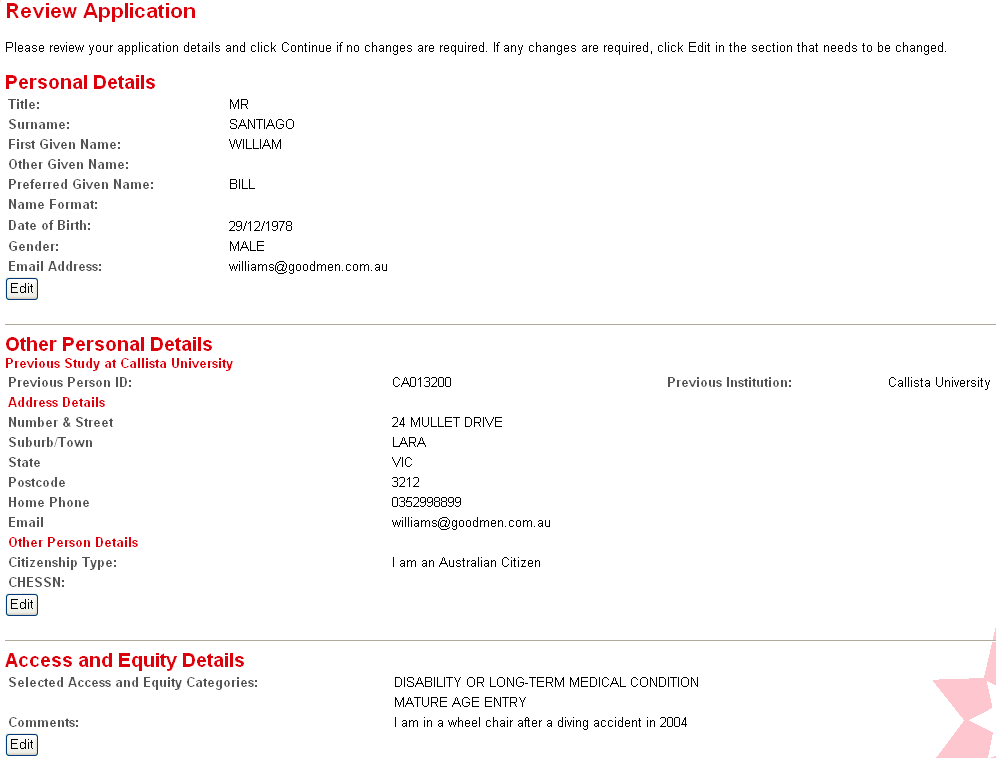
STEP 14
Applicant Portal Declaration (APAPPDCLR)
The purpose of this screen is to ask the applicant to confirm that they have read and accept the institution's declaration. The declaration is free text so that the institution can define the declaration as they see fit. The applicant cannot proceed without accepting the declaration.
Invoked From:
An example of what Step 14 could look like.

STEP 15
Submit Application (APPAPLSBMT)
The final step in the Admission application process requires the applicant to submit the application, which will then generate a receipt.
A brief summary of the applicant's personal details and course preferences recorded for the application are provided.
On pressing the 'Submit' button the Admission application process is completed. The transfer status of the Admission application and its components change to a System Status of PENDING, to indicate that the application has been completed by the applicant, and to inform the Applicant Portal Transfer Job (ADMJ5000) that the records are ready to be transferred to Callista SMS.
The applicant is then presented with a confirmation of a successful submission and a receipt number for use when contacting the institution. The receipt number is the sequence number of the application from the Applicant Portal admission application table.
An example of what Step 15 could look like.

In addition, an email is sent to the applicant when they submit their application. The email is confirmed by the institution and can contain the receipt number of the application.
A submission date is recorded when the Applicant submits the application.
When the Continue button is selected, this is an example of the next screen.

The user can now view their application or log out.
Invoked From:
Record Marketing Details (APMRKTNG)
This function is the last screen in the Apply for Standard Course process (although not considered a step) and allows applicants to answer questions in relation to marketing. For example, they might record how they found out about the courses. This information is useful to institutions as it can help identify which marketing campaigns are effective.
The questions and potential answers (where the answer is a pop list or radio button group) is defined in the template. The questions and selected answers are then passed to the update routine to be recorded.
This screen is not available if the student is using the Course Transfer process.
Invoked From:
Apply for Course Transfer - Steps 1-5
After selecting the Apply for Course Transfer Button in the Application List (APAPPLST), the following steps (steps 1 to 5 (pink arrows) in the diagram below) will appear in order - these are the steps that the student is presented with to complete their transfer.

STEP 1
Record Other Person Details (APAPPDTL)
When this application is accessed as a part of the Course Transfer process (system application type of Course Transfer), then only the Citizenship Type question and answer is displayed. This information is the only information required from this application for a Course Transfer.
The applicant is asked to choose a Citizenship Type. The Citizenship Type is an institution-defined value that is mapped to a system value of INTERNATIONAL or DOMESTIC (in ADMF0285).
If the system citizenship type entered is mapped to INTERNATIONAL, the following fields will be displayed for the applicant to enter:
They will be also be asked the question “Have you applied for permanent residency?” If the response is ‘Yes', the ‘Date of Application for Permanent Residency' field will be enabled.
If the system citizenship type selected is DOMESTIC, the CHESSN field will be displayed instead.
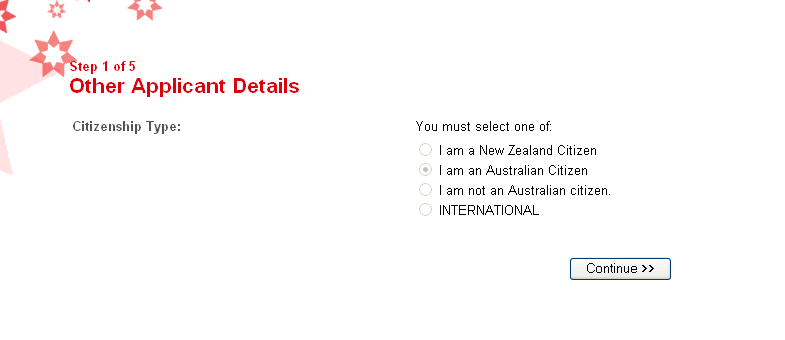
Invoked From:
Information shown on this screen is controlled by Maintain Applicant Portal Applicant Details (ADMF5100).
STEP 2
Record Course Details (Course Transfer) (APCRSTRNFR)
An existing student is able to apply for an Admissions Course Transfer through the Applicant Portal.
The 'Apply for Course Transfer' button in the Application List (APAPPLST) takes the student to the first of five steps. See the first image - Application List (APAPPLLST), above. This window - The Record Course Details (Course Transfer - APCRSTRNFR) is the second of five windows in the process. This window:
When this function is called from the Review/Edit Application function the navigation buttons will change from ‘Previous/Continue’ to ‘Cancel/Save and Return’.

When the Continue button is selected, this is an example of the next screen.
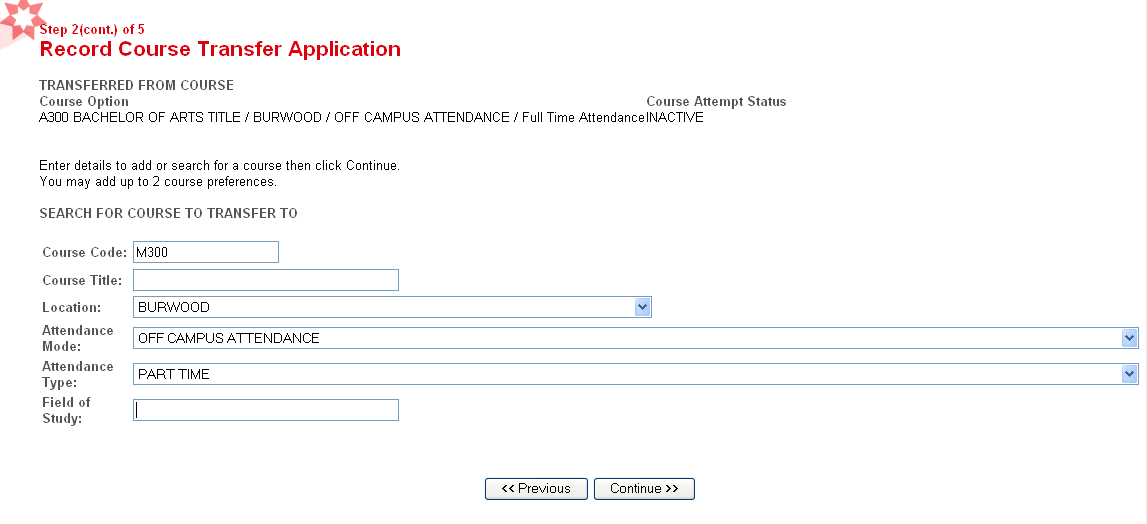
When the Continue button is selected, this is an example of the next screen.
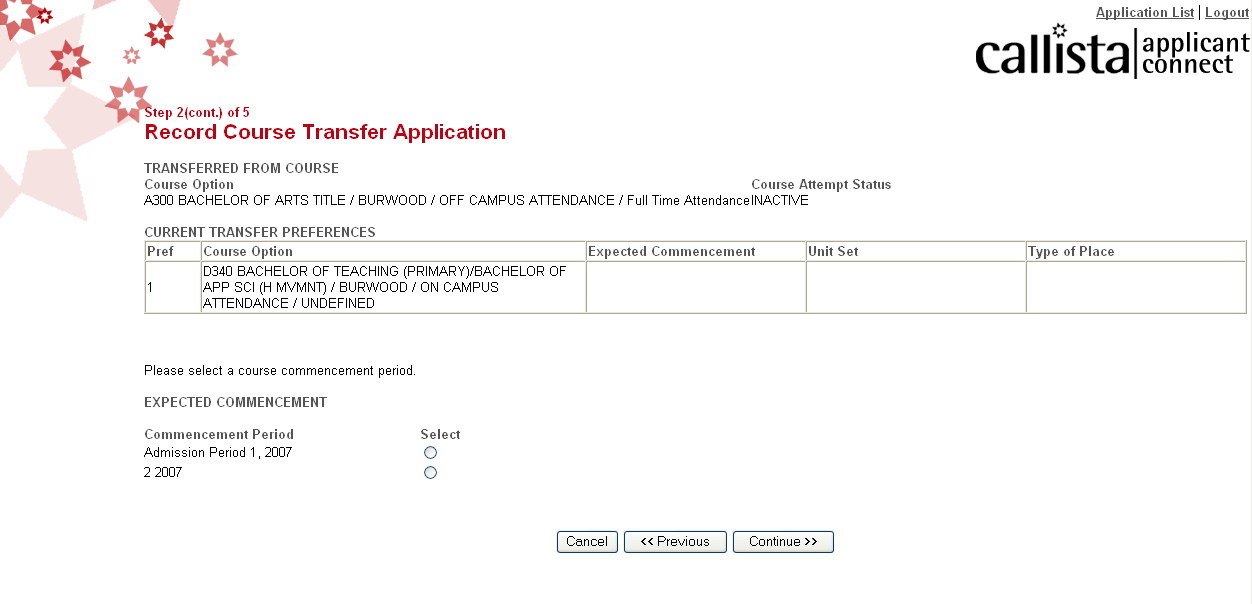
When the Continue button is selected, this is an example of the next screen.

Invoked From:
STEP 3
Review Application (APPAPLRVW)
This screen displays all information entered by the applicant on one page. Additionally, the applicant is able to click on links that navigate to the step selected to enable them to update the details. Following any updates, the applicant is able to navigate directly back to this page, bypassing any steps.
A button to enable the applicant to view the Review Application details in a printer-friendly format is provided.The Edit buttons are not displayed when the application is accessed directly from the Application List (APAPPLST).
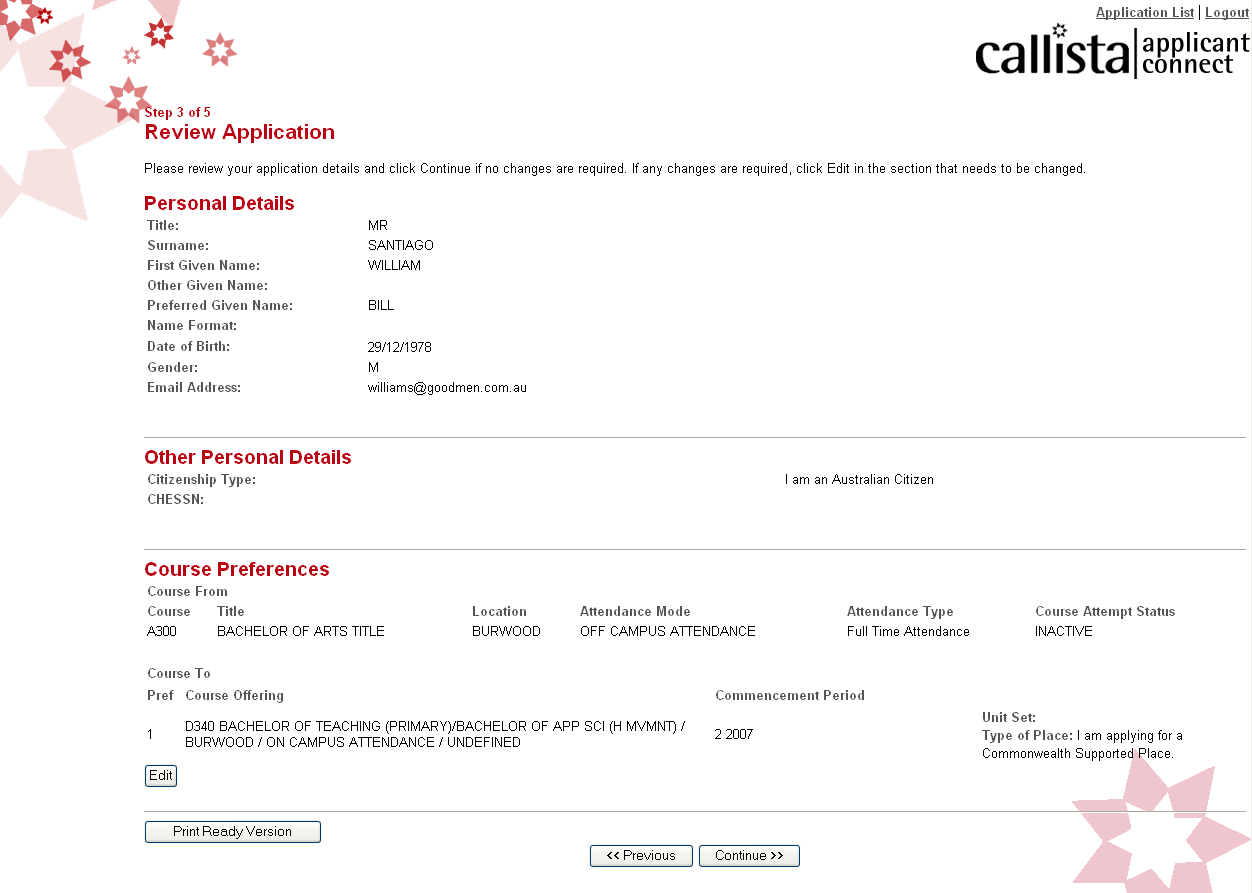
Invoked From:
STEP 4
Applicant Portal Declaration (APAPPDCLR)
The purpose of this screen is to ask the applicant to confirm that they have read and accept the institution's declaration. The declaration is free text so that the institution can define the declaration as they see fit. The applicant cannot proceed without accepting the declaration.

Invoked From:
STEP 5
Submit Application (APPAPLSBMT)
The final step in the Admission application process requires the applicant to submit the application, which will then generate a receipt.
A brief summary of the applicant's personal details and course preferences recorded for the application are provided.
On pressing the 'Submit' button the Admission application process is completed. The transfer status of the Admission application and its components change to a System Status of PENDING, to indicate that the application has been completed by the applicant.
The applicant is then presented with a confirmation of a successful submission and a receipt number for use when contacting the institution. The receipt number is the sequence number of the application from the Applicant Portal admission application table.
A submission date is recorded when the Applicant submits the application.
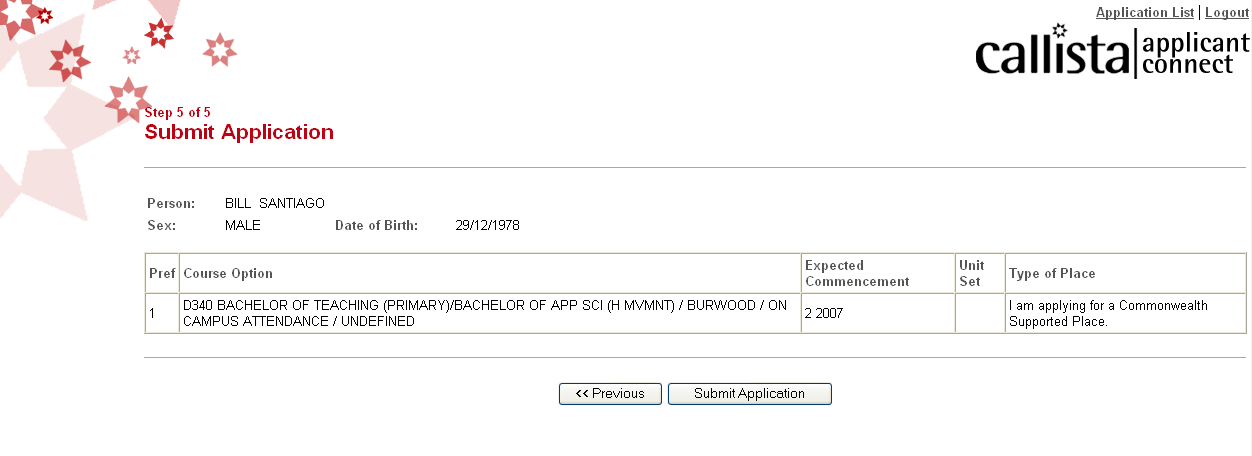
Invoked From:
To begin to use the Applicant Portal, the institution will need to have the following data configured:
History Information
| Release Information | Project | Change to Document |
| 15.0 | 1408 - PCs 75 & 76 | Added notes to APAPPLLST section regarding withdrawing an application & the new Withdraw Application button. Increased heading sizes & inserted section breaks. |
| 13.0.0.2, 13.1 | 1408 - PC73 | Added note to APEDUPLD step about max size limit for multiple documents uploaded. |
| 12.1.0.3, 12.1.1.2, 13.0.0.2, 13.1 | 1408 - PC144 Part 2 | Updated the APAPPLCRS and APCRSTRNFR sections regarding the 'Include Unavailable CCOs in Course Search Results' check box. |
| 13.1 | 1670 - Scholarship Applications | Added new validation in APCRACNT. |
| 13.1 | 1664 - Agents Lodging Applications via App. Portal | Added more information to introduction. |
| 13.0.0.2 | calipso 30787 | Updated intro. & included links to related pages. |
| 12.0.0.3 | 1408 - PC144 | Added reference to the 'Include Unavailable COOs in Course Search Results' check box in step 5 |
| 12.0.0.3 | 1408 - PC93 - Pre-Enrolment Overrides | Added note about updating Fee Category and/or Student Status prior to enrolment process occurring |
| 12.0 | 1457 eAdmissions Applicant Portal 4 | Updated various steps/sections, added new step (APSERVICE), updated step numbers, and updated screen shots and process diagram. |
| 11.1 | 1448 - ESOS compliance | Added ESOS agreement details in the APRESPOFFR section and added screen shot |
| 11.0.0.0.0.0 | 1408 - PC71-eAdmission Follow Up | Added note about Applicant Portal availability in APSCNDRYED and |
| 11.0.0.0.0.0 | 1353 - International Name | Added image for APCRACNT and note about name format |
| 10.1.0.0.0.0 | 1411 - Scholarships | Added new validation in APPAPDTL and new scholarship section in APAPPLLST |
| 10.0.0.0.0.0 | 1231 - eAdmissions - Applicant Portal 3 | Completely redesign layout to include images and page layout to images |
| 9.1.0.0.0.0 | 1221 - eAdmissions - Applicant Portal 2 | Update with new portal information (APADMTEST, APAPPDTL, APAPPLRVW, APAPPLSBMT, APAPPLST, APEDUPLD, APCRACNT and APEQACDTL) |
| 9.0.0.0.0.0 | 1194 - eAdmissions - Applicant Portal | New form |